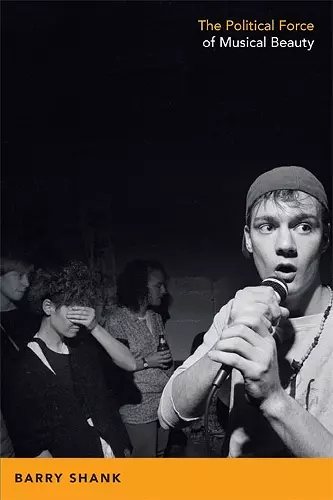The Political Force of Musical Beauty
Format:Paperback
Publisher:Duke University Press
Published:11th Apr '14
Currently unavailable, and unfortunately no date known when it will be back

In The Political Force of Musical Beauty, Barry Shank shows how musical acts and performances generate their own aesthetic and political force, creating, however fleetingly, a shared sense of the world among otherwise diverse listeners. Rather than focusing on the ways in which music enables the circulation of political messages, he argues that communities grounded in the act and experience of listening can give rise to new political ideas and expression. Analyzing a wide range of "beautiful music" within popular and avant-garde genres—including the Japanese traditions in the music of Takemitsu Toru and Yoko Ono, the drone of the Velvet Underground, and the insistence of hardcore punk and Riot grrrl post-punk—Shank finds that when it fulfills the promise of combining sonic and lyrical differences into a cohesive whole, musical beauty has the power to reorganize the basis of social relations and produce communities that recognize meaningful difference.
"Summer is the season for foreground music, when our desire for melodic accompaniment is on spectacular display. It cradles the widely held conviction, astutely explored by Barry Shank in The Political Force of Musical Beauty, that the word song does rotten justice to certain units of musical experience. As, for instance, when some tune, in the process of unfolding itself, appears at once to exist for us alone and to matter beyond measure. It can happen in a club or a car or a chair. Such an experience’s apparent privacy can make its 'political force'—Shank’s apposite term—difficult to capture. Shank draws these effects, and insights into the kinds of collectivity they suggest, from an impressive range of musical forms." -- Darby English * Artforum *
“While few people reading this magazine would object to the idea that new musical experiences can be radically transformative on an individual level, the conviction that music can influence broader political change is more problematic. Quickly clarifying that his book isn’t about how music can be a vehicle for sharing pre-existing political sentiments, Barry Shank instead provides examples of music that has created new shared senses of the world and revealed the political significance of sounds previously heard as noise.” -- Jon Marshall * The Wire *
“[T]his book is very well researched and abounds with fresh ideas. . . . Essential. Upper-division undergraduates through faculty.” -- T. R. Harrison * Choice *
“Shank has produced a very engaging, learned, and wide-ranging book on popular music in itself and especially as it slides in one direction or another to the likes of avant-garde music or art or performance.” -- Ian Balfour * Journal of Popular Music Studies *
“This is an important contribution to the debate about music’s relationship to politics, one that takes seriously and treats subtly the contribution of musical sounds and experiences. It takes risks and issues challenges, and we are indebted to Barry Shank for this (and much more) in his fine book.” -- John Street * Popular Music *
“[A]n admirable effort to probe the social and political stakes of music. . . . Shank is most persuasive in his long, interpretive musical descriptions. . . . Shank helps us see that music’s embrace of difference, combined with its ability to create shared experiences of the world, can make us more aware of inequality; this, in turn, can motivate us from within to express ourselves collectively.” -- Alice Miller Cotter * Notes *
"Shank’s work provides an important contribution to the study of music and its political potential. His close analysis of vastly different works through the lens of the political power of musical beauty will prove an invaluable contribution to the study of music writ large." -- Kara Attrep * American Studies *
ISBN: 9780822356585
Dimensions: unknown
Weight: 467g
344 pages